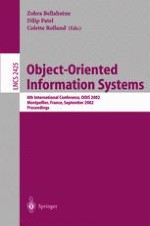2002 | Buch
Object-Oriented Information Systems
8th International Conference, OOIS 2002 Montpellier, France, September 2–5, 2002 Proceedings
herausgegeben von: Zohra Bellahsène, Dilip Patel, Colette Rolland
Verlag: Springer Berlin Heidelberg
Buchreihe : Lecture Notes in Computer Science
Enthalten in: Professional Book Archive
